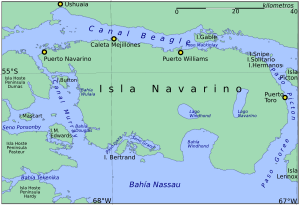Bahía Wulaia facts for kids
Bahia Wulaia is a bay located on the western side of Isla Navarino in southern Chile. This island is found along the Murray Channel. It is part of a region in southern Chile called Magallanes and Antartica Chilena Region.
Scientists have found old sites at Bahia Wulaia. These sites show that the Yaghan people lived here seasonally. They might have been here as long as 10,000 years ago. These places are known as the Wulaia Bay Dome Middens. The Yaghan built stone traps to catch fish in the bay's small inlets. These stone traps are still there today. The Yaghan people used them even into the 1800s.
In November 1859, a sad event happened at a settlement called Wulaia. Most of the crew and the captain of a ship were killed by the Yaghan. This ship, named Allen Gardiner, belonged to a group called the South American Missionary Society. It happened because of a big misunderstanding and cultural differences between the two groups.
The Ancient Yaghan People
The Yaghan people are thought to have moved to the main island of Tierra del Fuego a long time ago. They came from the north over a land bridge. This bridge was there more than 12,000 years ago. It disappeared after the last Ice Age ended. From Tierra del Fuego, the Yaghan easily traveled by canoe. They went to Navarino Island and other nearby islands.
The Yaghan are known as the "most southernmost aboriginal people in the history of the world." They made their homes on the coast of Navarino Island. They built round huts in the middle of ring-shaped piles of shells and other waste, called middens. The Yaghan moved from place to place during different seasons. Many old sites from this time have been found on the island. They mostly lived by catching fish and shellfish from the water.
Navarino Island has one of the largest numbers of old archaeological sites anywhere. This is likely because the Yaghan people moved around a lot. They set up many different settlements. Also, not many outsiders came to the island until the late 1800s. This meant their sites remained mostly untouched.
The Wulaia Incident
By the mid-1800s, people from Europe had met the Yaghan. The famous scientist Charles Darwin and Vice-Admiral Robert FitzRoy of the ship HMS Beagle met the Yaghan here in 1831. Other English people became worried about the lives of the indigenous peoples in this area. They started missions to teach them European languages and religion.
In England, a group first called the Patagonian Mission Society was formed. Their goal was to help the native people of southern Chile and Argentina. A missionary named George Packenham Despard came to a mission on Keppel Island in the Falklands. He brought his wife and children, including their adopted son Thomas Bridges.
Despard convinced Jemmy Button to visit the mission. Jemmy Button was a Yaghan man from Tierra del Fuego. He had visited England before on HMS Beagle. In 1858, Jemmy Button, his wife, and three children returned to Wulaia. At the same time, the British invited nine other Yaghan people to visit the mission.
These Yaghan people soon missed their homes. They had not had the same experiences as Jemmy Button. There were also big cultural differences between them and the British. In October 1859, a British crew on the schooner Allen Gardiner left Keppel Island. They were taking the Yaghan people back to Wulaia. They arrived on November 2 after a very difficult journey.
Four days later, the Yaghan people attacked. They were angry after an argument with the crew. They killed Captain Garland Phillips and almost all of the ship's crew who were on shore. The British group had been holding a Sunday church service in a small chapel. The British men, sailors, and a religious teacher were all killed. The only person who survived was the ship's cook. He was still on board the Allen Gardiner when the attack happened. He escaped in a small boat. He later made peace with the native people. Search parties found him alive on March 1, 1860. They also found the ship, which had been emptied and left behind.
After this attack, Despard asked to return to England with his family. His adopted son, Thomas Bridges, was 17 years old. He decided to stay at the mission on Keppel Island. He learned the Yaghan language. He spent his life creating a grammar and dictionary of the Yámana language. It contained more than 30,000 words. In 1871, he successfully helped set up a full mission at Ushuaia, Tierra del Fuego, with another missionary family.
See also
 In Spanish: Caleta Wulaia para niños
In Spanish: Caleta Wulaia para niños


